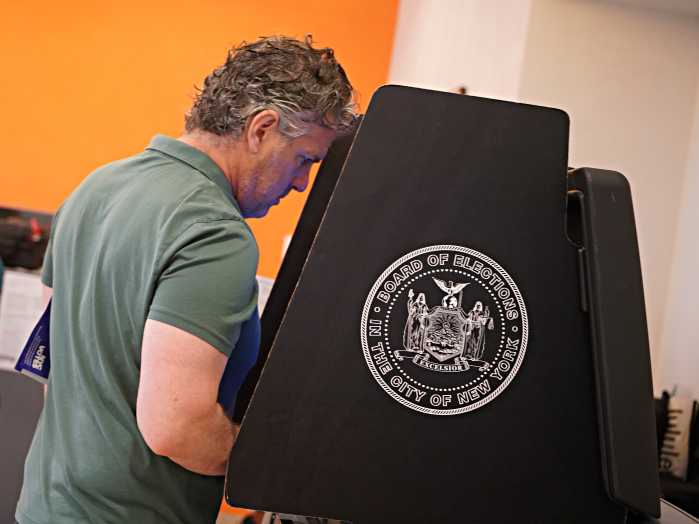 BY LENORE SKENAZY
BY LENORE SKENAZY
Playboy magazine used to be the illicit thrill that men of all ages hid in their sock drawers.
Now it is more like the socks. Even though the magazine recently decided to add naked ladies back into the mix (no nudes, it seems, was bad nudes), it is still hard to get excited by Playboy anymore. But to give props where props are due: It is also hard to imagine we would ever be as blase as we are today about sex, and even women’s lib, if it weren’t for Hugh Hefner and his crazy 1953 creation.
Hef was a frustrated cartoonist at the time, working in the Esquire subscription department. When his request for a $5 a week raise got turned down, he decided to strike out on his own. Somehow he pulled together $10,000 and prepared to launch a racy new magazine: Stag.
Fortunately for him, the name “Stag” was already taken. So instead he called it “Playboy.” The first edition featured a centerfold (a word we wouldn’t even have without Hef!) dubbed, “Sweetheart of the Month.” By the very next issue, the centerfold was rechristened “Playmate.” And as author Julie Keller has mused, “There is a vast ideological gap between the words.”
There sure is. “Sweetheart” harkened back to courtship. But a playmate is someone you play with. It is fun, but it isn’t forever.
Thus began the smashing of taboos.
The genius of Playboy was not that it published naked young flesh. You could buy dirty pictures even then. As Time Magazine noted in a cover story on Hefner at the height of his career — 1972, when Playboy was selling 7 million copies a month — “He took the old-fashioned, shame-thumbed girlie magazine, stripped off the plain wrapper, added gloss, class, and culture.”
And how! As its subscriber base grew, so did Playboy’s reputation as a purveyor of taste, showcasing some of the best writers around. So, yes, obligatory joke here: You really could read Playboy just for the articles.
Then again, you could read The New York Review of Books for the same thing. Did you?
Enough said.
The lofty writing not only provided gentlemen with an excuse for their subscriptions, it helped change the entire perception of non-marital sex, from dark, dirty doings with prostitutes to a sophisticated pastime men pursued with willing women of their own class. This, of course, required willing women. And that required a revolution.
Hefner himself has said he was a feminist before it was cool. Exactly how feminist remains one for the gender studies classes. Sure he “objectified” women’s bodies. But he also supported birth control (he had to), pre-marital sex (ditto), and sexual pleasure for both partners (why not?).
Ironically, one thing he did not seem to believe in was actual, earthy sexiness. Peter Bloch, a former editor at Penthouse, recalls being disappointed by his Playboy subscription every month.
“The girls were very cute, but they were photo-shopped and in weird poses,” he lamented. “Any woman I saw walking down the street seemed more sexy.”
It’s possible that’s because Hefner wasn’t really selling sex. He was selling lifestyle. The women were simply part of a modern man’s lair, along with a wet bar and hi-fi. That’s why Hef made sure all the advertising was aspirational. Howard Lederer, the magazine’s ad director, told Time in 1972: “We don’t want a reader to suddenly come on an ad that says he has bad breath.”
Martin Pazzani was brand manager at Smirnoff Vodka back in Playboy’s heyday.
“We spent tens of millions” on Playboy ads, he recalls. Today he the head of a premium Tequila, Tears of Llorona, and he not advertise in Playboy — or any magazine.
That’s part one of the one-two punch that knocked the wind out of Playboy.
“The internet was a problem for just about every existing media enterprise,” says Nat Ives, executive director of Advertising Age.
Of course, the Internet provided more than just a new ad medium. It provided more porn than all the Playmates of all time.
“Playboy changed the landscape, and then vice versa,” pop culture historian Robert Thompson sums it up.
Today the bunny logo, once so titillating, looks like something from a ’70s time capsule. But because it is still one of the most recognizable brands one earth, publicist Richard Laermer came up with a great idea for it:
Open a Playboy Museum.
Do it in Vegas. Showcase the man, the mansion, the magazine. Trace their trajectory across the times they changed. Fill the gift shop with Playboy overstock — mugs, sunglasses, key chains. And in the cafe, serving Heffacino?
Bunnies! Male, female, and gender fluid, wiggling their tails. Just like that, Playboy goes from creeky to cheeky again, and is celebrated for its amazing place in American history.
Not just its place in the sock drawer.
Lenore Skenazy is a keynote speaker, author of the book and blog Free-Range Kids, and a contributor at Reason.com.




































